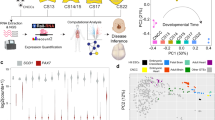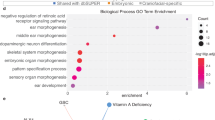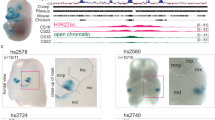Abstract
Craniofacial anomalies (CFAs) characterized by birth defects of skull and facial bones are the most frequent congenital disease. Genomic analysis has identified multiple genes responsible for CFAs; however, the underlying genetic mechanisms for the majority of CFAs remain largely unclear. Our previous study revealed that the Wwp2 E3 ubiquitin ligase facilitates craniofacial development in part through inducing monoubiquitination and activation of the paired-like homeobox transcription factor, Goosecoid (Gsc). Here we report that Gsc is also ubiquitinated and activated by the APCCdh1 E3 ubiquitin ligase, leading to transcriptional activation of various Gsc target genes crucial for craniofacial development. Consistenly, neural crest-specific Cdh1-knockout mice display similar bone malformation as Wwp2-deficient mice in the craniofacial region, characterized by a domed skull, a short snout and a twisted nasal bone. Mechanistically, like Wwp2-deficient mice, mice with Cdh1 deficiency in neural crest cells exhibit reduced Gsc/Sox6 transcriptional activities. Simultaneous deletion of Cdh1 and Wwp2 results in a more severe craniofacial defect compared with single gene deletion, suggesting a synergistic augmentation of Gsc activity by these two E3 ubiquitin ligases. Hence, our study reveals a novel role for Cdh1 in craniofacial development through promoting APC-dependent non-proteolytic ubiquitination and activation of Gsc.
Similar content being viewed by others
Log in or create a free account to read this content
Gain free access to this article, as well as selected content from this journal and more on nature.com
or
References
Alappat S, Zhang ZY, Chen YP . Msx homeobox gene family and craniofacial development. Cell Res 2003; 13:429–442.
Rice DP . Craniofacial anomalies: from development to molecular pathogenesis. Curr Mol Med 2005; 5:699–722.
Rotin D, Kumar S . Physiological functions of the HECT family of ubiquitin ligases. Nat Rev Mol Cell Biol 2009; 10:398–409.
Zou W, Chen X, Shim JH, et al. The E3 ubiquitin ligase Wwp2 regulates craniofacial development through mono-ubiquitylation of Goosecoid. Nat Cell Biol 2011; 13:59–65.
Peters JM . The anaphase promoting complex/cyclosome: a machine designed to destroy. Nat Rev Mol Cell Biol 2006; 7:644–656.
Burton JL, Tsakraklides V, Solomon MJ . Assembly of an APC-Cdh1-substrate complex is stimulated by engagement of a destruction box. Mol Cell 2005; 18:533–542.
Pfleger CM, Kirschner MW . The KEN box: an APC recognition signal distinct from the D box targeted by Cdh1. Genes Dev 2000; 14:655–665.
Garcia-Higuera I, Manchado E, Dubus P, et al. Genomic stability and tumour suppression by the APC/C cofactor Cdh1. Nat Cell Biol 2008; 10:802–811.
Bassermann F, Frescas D, Guardavaccaro D, Busino L, Peschiaroli A, Pagano M . The Cdc14B-Cdh1-Plk1 axis controls the G2 DNA-damage-response checkpoint. Cell 2008; 134:256–267.
Fujita T, Liu W, Doihara H, Date H, Wan Y . Dissection of the APCCdh1-Skp2 cascade in breast cancer. Clin Cancer Res 2008; 14:1966–1975.
Fujita T, Liu W, Doihara H, Wan Y . Regulation of Skp2-p27 axis by the Cdh1/anaphase-promoting complex pathway in colorectal tumorigenesis. Am J Pathol 2008; 173:217–228.
Gao D, Inuzuka H, Korenjak M, et al. Cdh1 regulates cell cycle through modulating the claspin/Chk1 and the Rb/E2F1 pathways. Mol Biol Cell 2009; 20:3305–3316.
Tudzarova S, Colombo SL, Stoeber K, Carcamo S, Williams GH, Moncada S . Two ubiquitin ligases, APC/C-Cdh1 and SKP1-CUL1-F (SCF)-beta-TrCP, sequentially regulate glycolysis during the cell cycle. Proc Natl Acad Sci USA 2011; 108:5278–5283.
Naoe H, Araki K, Nagano O, et al. The anaphase-promoting complex/cyclosome activator Cdh1 modulates Rho GTPase by targeting p190 RhoGAP for degradation. Mol Cell Biol 2010; 30:3994–4005.
Lasorella A, Stegmuller J, Guardavaccaro D, et al. Degradation of Id2 by the anaphase-promoting complex couples cell cycle exit and axonal growth. Nature 2006; 442:471–474.
Stegmuller J, Konishi Y, Huynh MA, Yuan Z, Dibacco S, Bonni A . Cell-intrinsic regulation of axonal morphogenesis by the Cdh1-APC target SnoN. Neuron 2006; 50:389–400.
Wan L, Zou W, Gao D, et al. Cdh1 regulates osteoblast function through an APC/C-independent modulation of Smurf1. Mol Cell 2011; 44:721–733.
Yamada G, Mansouri A, Torres M, et al. Targeted mutation of the murine goosecoid gene results in craniofacial defects and neonatal death. Development 1995; 121:2917–2922.
Lefebvre V, Li P, de Crombrugghe B . A new long form of Sox5 (L-Sox5), Sox6 and Sox9 are coexpressed in chondrogenesis and cooperatively activate the type II collagen gene. EMBO J 1998; 17:5718–5733.
Saito T, Ikeda T, Nakamura K, Chung UI, Kawaguchi H . S100A1 and S100B, transcriptional targets of SOX trio, inhibit terminal differentiation of chondrocytes. EMBO Rep 2007; 8:504–509.
Nagy A, Kenesi E, Rentsendorj O, et al. Evolutionarily conserved, growth plate zone-specific regulation of the matrilin-1 promoter: L-Sox5/Sox6 and Nfi factors bound near TATA finely tune activation by Sox9. Mol Cell Biol 2011; 31:686–699.
Danielian PS . Modification of gene activity in mouse embryos in uteroby a tamoxifen-inducible form of Cre recombinase. Curr Biol 1998; 8:1323–1326.
Surdenikova L, Ru F, Nassenstein C, Tatar M, Kollarik M . The neural crest- and placodes-derived afferent innervation of the mouse esophagus. Neurogastroenterol Motil 2012; 24:e517–525.
da Fonseca PC, Kong EH, Zhang Z, et al. Structures of APC/C(Cdh1) with substrates identify Cdh1 and Apc10 as the D-box co-receptor. Nature 2011; 470:274–278.
Geley S, Kramer E, Gieffers C, Gannon J, Peters JM, Hunt T . Anaphase-promoting complex/cyclosome-dependent proteolysis of human cyclin A starts at the beginning of mitosis and is not subject to the spindle assembly checkpoint. J Cell Biol 2001; 153:137–148.
Petersen BO, Wagener C, Marinoni F, et al. Cell cycle- and cell growth-regulated proteolysis of mammalian CDC6 is dependent on APC-CDH1. Genes Dev 2000; 14:2330–2343.
Zur A, Brandeis M . Securin degradation is mediated by fzy and fzr, and is required for complete chromatid separation but not for cytokinesis. EMBO J 2001; 20:792–801.
Hu D, Qiao X, Wu G, Wan Y . The emerging role of APC/CCdh1 in development. Semin Cell Dev Biol 2011; 22:579–585.
Meyer HJ, Rape M . Processive ubiquitin chain formation by the anaphase-promoting complex. Semin Cell Dev Biol 2011; 22:544–550.
Rape M, Reddy SK, Kirschner MW . The processivity of multiubiquitination by the APC determines the order of substrate degradation. Cell 2006; 124:89–103.
Wu T, Merbl Y, Huo Y, Gallop JL, Tzur A, Kirschner MW . UBE2S drives elongation of K11-linked ubiquitin chains by the anaphase-promoting complex. Proc Natl Acad Sci USA 2010; 107:1355–1360.
Dimova NV, Hathaway NA, Lee BH, et al. APC/C-mediated multiple monoubiquitylation provides an alternative degradation signal for cyclin B1. Nat Cell Biol 2012; 14:168–176.
Liu J, Wan L, Liu J, et al. Cdh1 inhibits WWP2-mediated ubiquitination of PTEN to suppress tumorigenesis in an APC-independent manner. Cell Discov 2016; 2:15044. doi:10.1038/celldisc.2015.44
Gao CY, Zelenka PS . Cyclins, cyclin-dependent kinases and differentiation. Bioessays 1997; 19:307–315.
Rivera-Perez JA, Mallo M, Gendron-Maguire M, Gridley T, Behringer RR . Goosecoid is not an essential component of the mouse gastrula organizer but is required for craniofacial and rib development. Development 1995; 121:3005–3012.
Boucher DM, Schaffer M, Deissler K, et al. goosecoid expression represses Brachyury in embryonic stem cells and affects craniofacial development in chimeric mice. Int J Dev Biol 2000; 44:279–288.
Hahn M, Jackle H . Drosophila goosecoid participates in neural development but not in body axis formation. EMBO J 1996; 15:3077–3084.
Latinkic BV, Smith JC . Goosecoid and mix.1 repress Brachyury expression and are required for head formation in Xenopus. Development 1999; 126:1769–1779.
Tassabehji M, Hammond P, Karmiloff-Smith A, et al. GTF2IRD1 in craniofacial development of humans and mice. Science 2005; 310:1184–1187.
Yao J, Kessler DS . Goosecoid promotes head organizer activity by direct repression of Xwnt8 in Spemann's organizer. Development 2001; 128:2975–2987.
Boehm JS, Hession MT, Bulmer SE, Hahn WC . Transformation of human and murine fibroblasts without viral oncoproteins. Mol Cell Biol 2005; 25:6464–6474.
Wei W, Ayad NG, Wan Y, Zhang GJ, Kirschner MW, Kaelin WG, Jr . Degradation of the SCF component Skp2 in cell-cycle phase G1 by the anaphase-promoting complex. Nature 2004; 428:194–198.
Acknowledgements
We thank Brian North, Shavali Shaik, Alan W. Lau, Matthew B. Greenblatt, Hiroyuki Inuzuka and Pengda Liu for critical reading of the manuscript, and members of the Zou and Wei labs for useful discussions. This work was supported by the Chinese Ministry of Science and Technology (MOST, 973 Program; 2014CB964704 and 2015CB964503), the National Natural Science Foundation of China (NSFC; 31371463) and NIH (GM089763, GM094777 and CA177910 to WW). WZ is a scholar of the 'National 1000 Young Talents Program of China' and 'the National Science Fund for Excellent Young Scholars' (NSFC; 81322027). WW is a Leukemia and Lymphoma Society Scholar and ACS Research Scholar.
Author information
Authors and Affiliations
Corresponding authors
Additional information
( Supplementary information is linked to the online version of the paper on the Cell Research website.)
Supplementary information
Supplementary information, Figure S1
Luciferase reporter constructs used in different luciferase assay. (PDF 410 kb)
Supplementary information, Figure S2
Cdh1 conditional knockout led to craniofacial development defects. (PDF 8349 kb)
Supplementary information, Figure S3
Cre virus did not induce Cdh1 knockdown in calvarial cells with WT-Cdh1 genetic background. (PDF 129 kb)
Supplementary information, Figure S4
Immunoblot analysis of whole cell lysates derived from ATDC5 cells infected with the indicated lentiviral constructs. (PDF 500 kb)
Rights and permissions
About this article
Cite this article
Shao, R., Liu, J., Yan, G. et al. Cdh1 regulates craniofacial development via APC-dependent ubiquitination and activation of Goosecoid. Cell Res 26, 699–712 (2016). https://doi.org/10.1038/cr.2016.51
Received:
Revised:
Accepted:
Published:
Issue date:
DOI: https://doi.org/10.1038/cr.2016.51
Keywords
This article is cited by
-
The role of WWP1 and WWP2 in bone/cartilage development and diseases
Molecular and Cellular Biochemistry (2024)
-
The role of E3 ubiquitin ligase WWP2 and the regulation of PARP1 by ubiquitinated degradation in acute lymphoblastic leukemia
Cell Death Discovery (2022)
-
Gene regulatory network from cranial neural crest cells to osteoblast differentiation and calvarial bone development
Cellular and Molecular Life Sciences (2022)
-
Beraprost ameliorates postmenopausal osteoporosis by regulating Nedd4-induced Runx2 ubiquitination
Cell Death & Disease (2021)
-
Reply to ‘Dissecting the role of miR-140 and its host gene’
Nature Cell Biology (2018)



